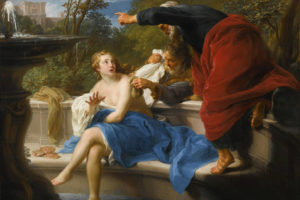WSJ Historically Speaking: The Pleasures and Perils of the Garden

HR28T4 POMPEO BATONI LUCCA 1708 – 1787 ROME SUSANNA AND THE ELDERS PHOTO: ALAMY
When the British philosopher Sir Francis Bacon wrote in a 1625 essay that “God Almighty first planted a garden, and indeed, it is the purest of human pleasures,” he knew that his readers would immediately think of the Garden of Eden, the setting for humankind’s downfall in sin. So which was it, a place of simple delights or of awful temptations? Historically, it turns out, gardens have been both.
Bacon was harking back not just to the Bible but to the ancient association of gardens, particularly enclosed ones, with paradise. Cultures from the Romans to the Aztecs built walled gardens, and the very word “paradise” comes from the ancient Persian words “pairi” and “diz,” meaning “around” and “to create (a wall)”—hence a walled space or garden.
In Asia, an enclosed garden provided communion with the gods and spiritual healing. Islamic cultures around the Mediterranean conceived of walled gardens as sites of respite and fantasy. The adventure of many a princess in “A Thousand and One Nights” begins with a tryst in the walled garden.
For societies shaped by the Bible, fears about sin and corruption and an insistence on sexual purity took root in the walled garden. In the “Song of Songs,” a garden becomes a metaphor for protecting the beloved from unwanted attention: “A garden enclosed is my sister, my spouse; a spring shut up, a fountain sealed.” But a garden is hardly a perfect refuge. In the “Book of Daniel,” it is where the lustful Elders violate Susanna’s innocent bath.
This tension carried over to the Middle Ages, whose poets turned the walled garden into an idealized picture of court life, with the chaste beloved at its center. The great Italian humanist Giovanni Boccaccio (1313-1375) mercilessly satirized this tradition in “The Decameron,” where one story takes place in a walled garden inhabited by sex-mad nuns and a willing gardener.
After Boccaccio, it became popular to dwell on the garden’s potential for sin rather than salvation. Shakespeare’s audiences would have been attuned to the serpent-in-Eden metaphor implicit in the poisoning of Hamlet’s father while he slept in the royal orchard.
In the 19th century, the Victorians reimagined gardens as a symbol of nature threatened by man. Nathaniel Hawthorne’s 1844 short story “Rappaccini’s Daughter” concerns a young student who beholds, in a locked garden, the beautiful daughter of a mysterious scientist. It turns out that the garden’s plants are poisonous—and the girl, raised in their midst, is poisonous as well. The student’s attempt to rescue her ends disastrously, their young love thwarted by scientific hubris.
T.S. Eliot famously began “The Waste Land” by combining these contradictory strands of garden lore:
April is the cruellest month, breeding
Lilacs out of the dead land, mixing
Memory and desire, stirring
Dull roots with spring rain.
I must confess to having no such ambivalence as the “dull roots” of my own garden spring to life again in this glorious season. For me, April is the month of hope and promise, filled with expectation for the bounty to come.
